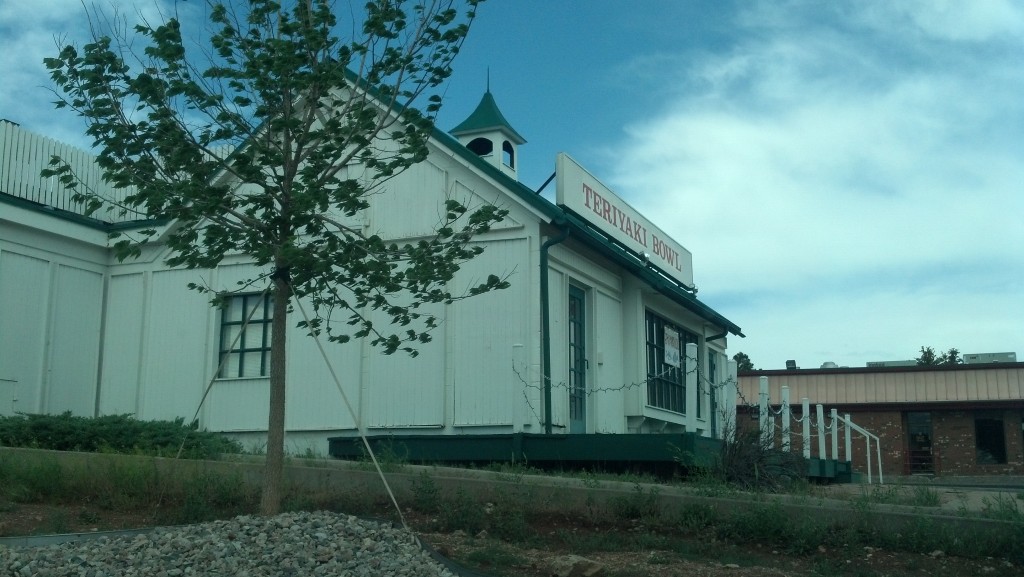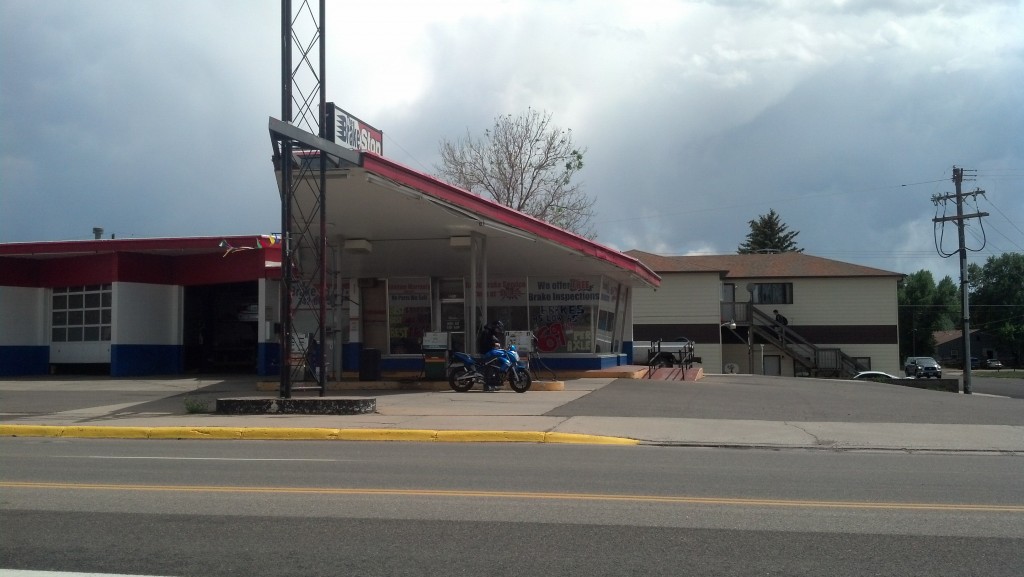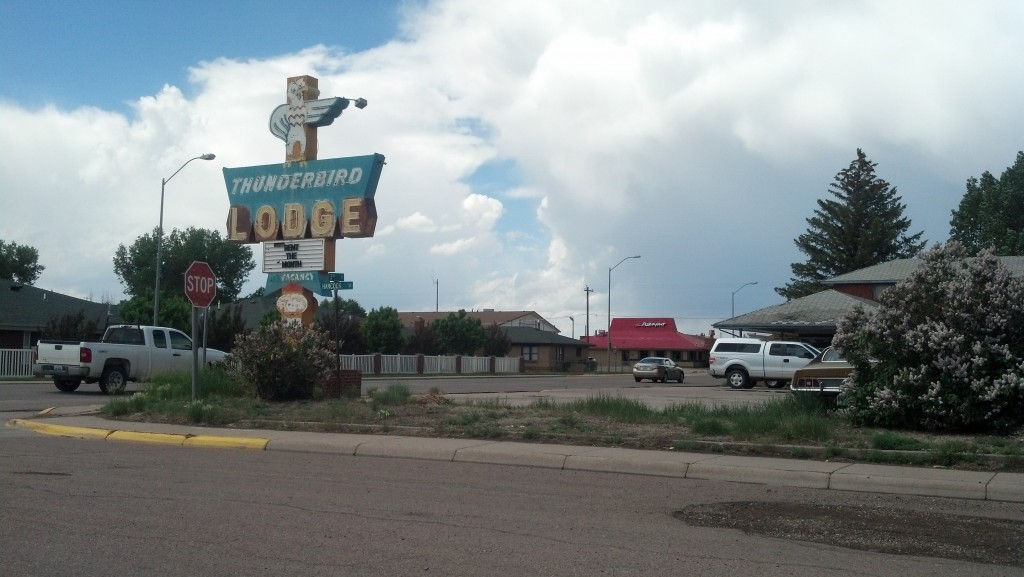LARAMIE, Wyo. — Before driving through town, I didn’t know much about Wyoming’s third-largest city except that it was the home of the University of Wyoming and the site where Matthew Shepard was brutally murdered in 1998. After I passed through Laramie on my way west, I didn’t know much more than when I came.
This is where the Lincoln Highway, following U.S. 30, diverges from Interstate 80 for roughly 95 miles before reconnecting near the dusty unincorporated settlement of Walcott.
Laramie’s downtown, set on a grid of square blocks east of the Union Pacific Railroad tracks, seemed relatively charming, but there wasn’t much here that compelled me to go out to explore.
On my way into town, however, a place called the Teriyaki Bowl caught my attention for an odd reason: It had the classic characteristics of a Long John Silver’s franchise location.
It had a symmetrical pseudo-Colonial design with exterior wooden planks arranged vertically, a cupola on the roof and two doors flanking a squared-off bay window. There’s nothing inherent in this cookie-cutter design that screams out “I am a place that pretends to be dockside where you can get fried fish, tartar sauce, buttered corn-on-the-cob nibblers and hush puppies,” but for most Americans familiar with 1970s and 1980s suburban corridors, this standard design is something instantly identified with Long John Silver’s.
According to Fast Food: Roadside Restaurants in the Automobile Age, the design was supposedly inspired by an “early American fishing village” and something that would “appear as acceptable in 2090 as it was in 1790.”
But the chain began adapting that design identity about a decade ago.
Back in May 2001, QSR, a magazine catering to the quick-service restaurant industry, reported:
The new design integrates the longtime LJS look of its yellow building and blue roof and cupola (structure surmounting a roof) with updated cupola, color scheme and graphics. The new restaurant design for the country’s largest seafood QSR features updated exterior seafood graphic and signage, with close- up food shots designed to appear as individual panels of a billboard. There are awnings reminiscent of the oceanside outdoor seafood stands.
At some point, Laramie’s infatuation with its Long John Silver’s location ended and a new business set up shop serving Asian food. In fact, I had seen at least five or six Asian restaurants on my trip that had taken up residence in a former Long John Silver’s location.
I had a filling lunch back in Cheyenne so I wasn’t tempted to check out the Teriyaki Bowl. It looked half-way deserted in any regard. But looks can be deceiving. The Teriyaki Bowl, despite its “dilapidated” decor, has generated a handful of positive reviews:
If you are scared of the appearance from the outside it doesn’t get a whole lot nicer on the inside. However that’s not the point, good food, that’s fresh, fast and most made to order. In a college town that lacks a lot of culture it’s a diamond in the rough. Give it a try!
From a TripAdvisor review titled “Heaven”:
Unbelievable how much food you get for the price. Beef is kind of tough, but everything else I’ve had from there is delicious. Amazing sushi. I would recommend getting the food to go as the atmosphere is not so good.
Post continues below …
Suburbia, of course, is easily replaceable and adaptable. Nearby the Teriyaki Bowl on Grand Avenue was the Brake Shop, an auto-repair business. Back in the day, I’m sure this structure was an incredibly modern landmark in Laramie. It was clearly meant to stand out with its distinctive pitched red-banded triangular roof held up by a three-sided column that’s braced with X-shaped internal supports.
I had seen plenty of old gas stations along the Lincoln Highway. Many were vacant, abandoned or had been renovated for other purposes, like the Mexican bakery I came across in Lexington, Neb. The most exceptional designs involved some sort of unusual or futuristic-looking canopy to shelter car owners while pumping gas. During the height of the automobile age in the United States, gas station design was just as important as car design, something that needed to capture and express the energy of mobility in a sleek package. These days, the architecture of the standard Shell or Amoco station is mostly unremarkable and uninspired.
Today, a place like the Brake Shop seems like a relic. And the Lincoln Highway is full of these relics.
On the way out of town on U.S. 30, faded elements of the old road west reappeared. The Thunderbird Lodge at 3rd and Hancock streets, which sits opposite a Pizza Hut, looked like it hadn’t changed much since the Johnson administration. This motel caught my eye because of its aging but awesome yellow-and-blue neon sign, complete with a stylized eagle and message advertising “Rent the Month.” (I’m not sure what I would do for a month in Laramie.)
This stretch of U.S. 30 is where Laramie essentially ended and the desolation of rural Wyoming picked back up. I wasn’t sure what to expect heading west from this final outpost of civilization but there was no turning back at this point.




That Pizza Hut with the triangle windows and distinctive roof is another iconic bit of American Everytown. I’ve seen them made into Mexican, Asian, Italian,and especially Bar-B-Que restaurants. But also churches. Lots of churches.
A question… are you avoiding people on purpose, as a point of style? There doesn’t seem to be anyone around, in your stories or photos.
Re: people. Yes and no. I generally feel that I’m an observer on this trip so I’m trying to be more of a fly on the wall. But for certain stretches of the trip, I actually didn’t really have a chance to interact with people because some of these places were completely desolate or nearly desolate. I also consider it rude to take photos of people without their permission. I’ve found that when traveling in other countries, taking photos of people without permission is a big breach of etiquette and as I’ve been traveling. Americans, I’ve found, don’t necessarily respect that courtesy. (But that’s painting with a broad brush stroke.) But as a preview for down the road, I have notebook full of details of some colorful characters I interacted with or observed. And I have a piece planned for the end of this journey detailing my interactions with people comparing their city to others, complaining about (or praising) the place where they live or another city and my assessment of that overall comparison of place.
My favorite Long John Silvers conversion is Tuptim, in Ann Arbor (aka Long John Thai).